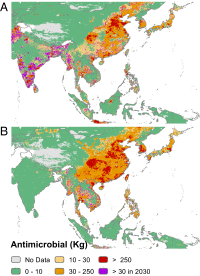Global trends in antimicrobial use in food animals
- PMID: 25792457
- PMCID: PMC4426470
- DOI: 10.1073/pnas.1503141112
Global trends in antimicrobial use in food animals
Abstract
Demand for animal protein for human consumption is rising globally at an unprecedented rate. Modern animal production practices are associated with regular use of antimicrobials, potentially increasing selection pressure on bacteria to become resistant. Despite the significant potential consequences for antimicrobial resistance, there has been no quantitative measurement of global antimicrobial consumption by livestock. We address this gap by using Bayesian statistical models combining maps of livestock densities, economic projections of demand for meat products, and current estimates of antimicrobial consumption in high-income countries to map antimicrobial use in food animals for 2010 and 2030. We estimate that the global average annual consumption of antimicrobials per kilogram of animal produced was 45 mg⋅kg(-1), 148 mg⋅kg(-1), and 172 mg⋅kg(-1) for cattle, chicken, and pigs, respectively. Starting from this baseline, we estimate that between 2010 and 2030, the global consumption of antimicrobials will increase by 67%, from 63,151 ± 1,560 tons to 105,596 ± 3,605 tons. Up to a third of the increase in consumption in livestock between 2010 and 2030 is imputable to shifting production practices in middle-income countries where extensive farming systems will be replaced by large-scale intensive farming operations that routinely use antimicrobials in subtherapeutic doses. For Brazil, Russia, India, China, and South Africa, the increase in antimicrobial consumption will be 99%, up to seven times the projected population growth in this group of countries. Better understanding of the consequences of the uninhibited growth in veterinary antimicrobial consumption is needed to assess its potential effects on animal and human health.
Keywords: antimicrobials; drug resistance; linear regression; livestock; mapping.
Conflict of interest statement
The authors declare no conflict of interest.
Figures




Comment in
-
Ominous projections for global antibiotic use in food-animal production.Proc Natl Acad Sci U S A. 2015 May 5;112(18):5554-5. doi: 10.1073/pnas.1505312112. Epub 2015 Apr 28. Proc Natl Acad Sci U S A. 2015. PMID: 25922534 Free PMC article. No abstract available.
-
Antimicrobial use in aquaculture: Some complementing facts.Proc Natl Acad Sci U S A. 2015 Jun 30;112(26):E3317. doi: 10.1073/pnas.1508952112. Epub 2015 Jun 4. Proc Natl Acad Sci U S A. 2015. PMID: 26045495 Free PMC article. No abstract available.
Similar articles
-
Excessive use of medically important antimicrobials in food animals in Pakistan: a five-year surveillance survey.Glob Health Action. 2019;12(sup1):1697541. doi: 10.1080/16549716.2019.1697541. Glob Health Action. 2019. PMID: 31795863 Free PMC article.
-
Global trends in antimicrobial resistance in animals in low- and middle-income countries.Science. 2019 Sep 20;365(6459):eaaw1944. doi: 10.1126/science.aaw1944. Science. 2019. PMID: 31604207
-
Ominous projections for global antibiotic use in food-animal production.Proc Natl Acad Sci U S A. 2015 May 5;112(18):5554-5. doi: 10.1073/pnas.1505312112. Epub 2015 Apr 28. Proc Natl Acad Sci U S A. 2015. PMID: 25922534 Free PMC article. No abstract available.
-
Environmental and human health challenges of industrial livestock and poultry farming in China and their mitigation.Environ Int. 2017 Oct;107:111-130. doi: 10.1016/j.envint.2017.07.003. Epub 2017 Jul 15. Environ Int. 2017. PMID: 28719840 Review.
-
Control of the development and prevalence of antimicrobial resistance in bacteria of food animal origin in Japan: a new approach for risk management of antimicrobial veterinary medicinal products in Japan.Foodborne Pathog Dis. 2014 Mar;11(3):171-6. doi: 10.1089/fpd.2013.1649. Epub 2014 Jan 4. Foodborne Pathog Dis. 2014. PMID: 24387636 Review.
Cited by
-
Urinary Antibiotics and Dietary Determinants in Adults in Xinjiang, West China.Nutrients. 2022 Nov 10;14(22):4748. doi: 10.3390/nu14224748. Nutrients. 2022. PMID: 36432435 Free PMC article.
-
Consumers' knowledge, attitude, and behavior towards antimicrobial resistance and antimicrobial use in food production in China.Front Public Health. 2022 Sep 23;10:1015950. doi: 10.3389/fpubh.2022.1015950. eCollection 2022. Front Public Health. 2022. PMID: 36211698 Free PMC article.
-
Analysis of Resistance Gene Diversity in the Intestinal Microbiome of Broilers from Two Types of Broiler Farms in Hebei Province, China.Antibiotics (Basel). 2023 Nov 27;12(12):1664. doi: 10.3390/antibiotics12121664. Antibiotics (Basel). 2023. PMID: 38136698 Free PMC article.
-
Market Chickens as a Source of Antibiotic-Resistant Escherichia coli in a Peri-Urban Community in Lima, Peru.Front Microbiol. 2021 Mar 2;12:635871. doi: 10.3389/fmicb.2021.635871. eCollection 2021. Front Microbiol. 2021. PMID: 33737922 Free PMC article.
-
Antimicrobial Peptides as Potential Alternatives to Antibiotics in Food Animal Industry.Int J Mol Sci. 2016 May 3;17(5):603. doi: 10.3390/ijms17050603. Int J Mol Sci. 2016. PMID: 27153059 Free PMC article. Review.
References
-
- Food and Drug Administration (2010) CVM Updates - CVM Reports on Antimicrobials Sold or Distributed for Food-Producing Animals (Food Drug Admin, Silver Spring. MD). Available at www.fda.gov/AnimalVeterinary/NewsEvents/CVMUpdates/ucm236143.htm. Accessed March 10, 2015.
-
- Laxminarayan R, et al. Antibiotic resistance-the need for global solutions. Lancet Infect Dis. 2013;13(12):1057–1098. - PubMed
-
- Graham JP, Evans SL, Price LB, Silbergeld EK. Fate of antimicrobial-resistant enterococci and staphylococci and resistance determinants in stored poultry litter. Environ Res. 2009;109(6):682–689. - PubMed
Publication types
MeSH terms
Substances
Grants and funding
LinkOut - more resources
Full Text Sources
Other Literature Sources
Medical
Miscellaneous

